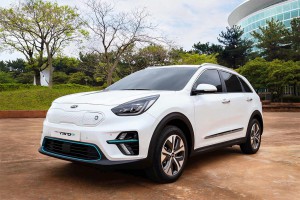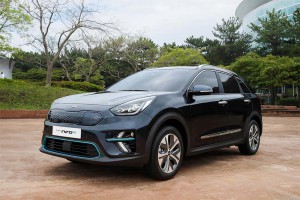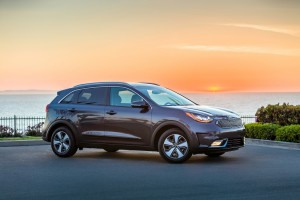We got a first look at the concept version of Kia’s all-electric Niro model during the Consumer Electronics Show earlier this year. The Korean carmaker has now pulled the wraps off the production model during the Fifth International Electric Vehicle Expo in Seoul.
A quick glance suggests the version that will be rolling into showrooms is a bit more conservative than the CES show car, with relatively conventional lights and bumpers. Perhaps the biggest difference between the Niro EV and earlier versions of the crossover can be seen in the textured, albeit solid, grille – which actually bears more than a passing likeness to the snout on the all-electric Hyundai Kona that debuted at the New York International Auto Show barely a month ago.
Kia is being sparse when it comes to offering details about the Niro EV, though it did indicate the battery-electric vehicle will be offered with a choice of two different batteries – at least in some markets – the more powerful, 64 kWh pack will provide enough energy to travel an estimated 236 miles between charges, the 39.2 kWh pack reducing range to around 149 miles.
(Kia bolsters line-up with launch of new Rio GT and ceed models. Click Here to check them out.)
At 236 miles, the Niro EV will come in just 2 miles short of the Chevrolet Bolt, but well ahead of the Tesla Model 3 sedan’s range – at least the version with the standard-issue battery.
The decision to offer a long-range battery stands in sharp contrast to what was done by sibling Korean brand Hyundai. Though its Ioniq model shares the same basic underpinnings as the Niro, the new Ioniq EV offers just 28 kWh of storage, enough to travel only 124 miles between charges, according to the EPA. (A longer-range version reportedly is under development but, for now, it’s the Kona that shares Niro’s 64 kWh battery.)
Back at CES we were advised the production car will be fitted with a single electric motor capable of producing 150 kilowatts, or about 201 horsepower. With the hefty torque of electric propulsion, we’d expect it to be reasonably peppy. While not an apples-to-apples comparison consider the performance of the second-generation, 2018 Nissan Leaf that produces 147 horsepower and 236 pound-feet of torque. It hits 60 in about eight seconds, or a full two seconds faster than the original, and much less powerful Leaf.
Along with the dimpled version of the brand’s trademark “tiger nose” grille, the new Kia Niro EV is distinguished by its “arrowhead” LED daytime running lights and distinctive air intakes.
(For more on the Kia Niro EV Concept, Click Here.)
As with the concept version, it appears that the EV may be ever so slightly larger than the hybrid and plug-in versions of Niro, reflecting the need for a thicker floorpan housing the CUV’s batteries. But it is clearly toned down from what we saw in Las Vegas last January, and no surprise, as Seung-bin Yim, a design director at Kia, told us then that, “The production car will not be as aggressive (in styling) as the concept.”
The Kia Niro EV Concept featured a high-tech cabin with a number of advanced driver assistance systems, not all expected on the production model, notably its prototype autonomous driving capabilities. But, we were told at CES, the street version could borrow the semi-autonomous Highway Driving Assist technology first introduced on the Stinger. Meanwhile, Kia does confirm the production Niro EV will get frontal collision avoidance assistance, lane departure assistance, smart cruise control, and rear collision warning.
The Niro EV will roll into Korean showrooms first, with that expected late in 2018. The automaker claims to already have 5,000 advance orders in hand for the home market.
We expect to find out more about the U.S. and European roll-outs during a preview at the Paris Motor Show next autumn, though pricing likely won’t be revealed until closer to Niro EV’s on-sale date in 2019.
(Click Here to check out the new look for the Kia K900 luxury sedan.)



